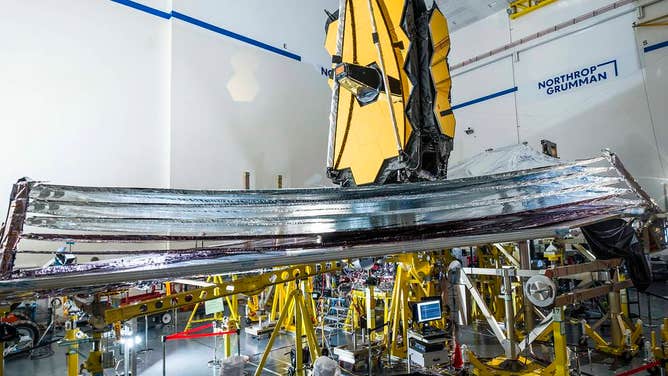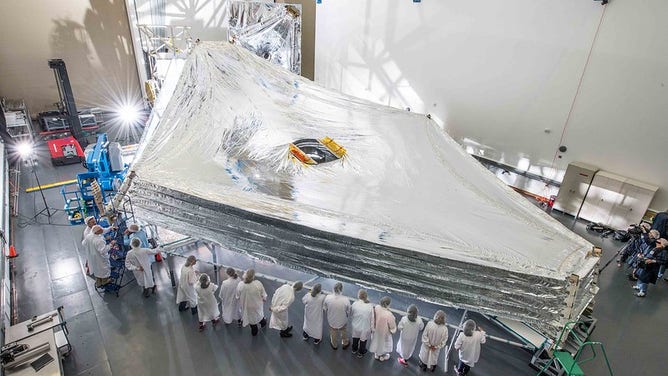Flawless launch will allow James Webb Space Telescope to further its lifespan in space
Webb's next milestone will be to complete the deployment of its massive sunsheild.

The James Webb Space Telescope. (Image: NASA)
The first two weeks in space for the James Webb Space Telescope have been going well, so well, that NASA says it should have more fuel than expected to extend the observatory's mission in space.
Webb launched from French Guiana on an Ariane 5 rocket on Christmas morning, and since then, Webb's mission team has been working 12-hour shifts to make sure the telescope's journey continues to go as planned.
The observatory has a five-layer sunshield the size of a tennis court and a 21-foot diameter gold-plated primary mirror. Webb was folded up for liftoff to fit inside the Ariane 5 rocket's nose cone. Now, the spacecraft must go through the long process of emerging from its launch cocoon in space.
Webb's mission managers with NASA and Northrop Grumman provided an update Monday saying that everything is going smoothly for the most powerful telescope ever built, minus a few minor issues.
A few days after liftoff, NASA officials said the launch trajectory was so precise that Webb won't need to use as much fuel to get to its final destination. JWST is traveling through space to reach the second Lagrange point, 1 million miles from Earth. However, it's unclear how much more time these fuel savings will buy Webb.
NASA JWST's Project Manager Bill Ochs said based on initial calculations, the observatory should continue working "a lot more than 10" years, which was the mission's original lifespan. More analysis is needed to determine the new mission length, according to Ochs.
The spacecraft has already made two planned course-correction burns, and the next milestone will be to complete the deployment of Webb's massive sunshade. It's an essential part of the spacecraft because it protects Webb's science instruments from the sun, keeping them at the frigid temperatures needed to operate. Each kite-shaped layer blocks more heat than the last, radiating heat out into space from between the five layers.
With five layers, it's a multi-day process, and each layer must be tensioned before the next layer can be complete.
Amy Lo, Webb alignments engineer with Northrop Grumman, explained that every layer follows a deployment sequence that is designed to stop at any point if needed.
"We can stop at any time and do a little bit of a reverse and then keep going," Lo said, adding so far, there have been no issues with the sunshield deployment.

Webb's Sunshield test unit stacked and expanded at a cleanroom in the Northrop Grumman facility in Redondo Beach, California. (Image: NASA/Chris Gunn)
Tensioning of the first layer began Monday and was expected to take most of the day. The following four layers should all be complete over the next four days.
"We have tested this multiple times on the ground. And given that our telemetry matches the ground testing so well, we are expected to have smooth sailing," Lo continued.
Over the past few days, Webb's team has worked through two issues. Ochs described some growing pains during the first weeks in space.
"We are still in the getting-to-know-you phase with the telescope. All satellites will always be a little bit different than they are on the ground, and it takes time to get to know that understand the characteristics," Ochs said.
The spacecraft's solar arrays were not quite keeping up with observatory activities, causing the battery to drain down, explained Lo. After ground testing on testbeds at Northrop Grumman facilities in California, teams "rebalanced" the arrays. The factory reset appears to have done the trick.
Lo said the arrays are now providing the level of power needed on Webb.
The second issue involved the motors on the spacecraft used to open the sunshield layers. Lo said the motors were running a little warm. The decision was made to adjust Webb's position in space that would shine less direct sunlight on the hardware, and now the motors "are nice and cool."
For a mission 25 years in the making that involved a lot of delays, Webb has had a less dramatic start.
"The best thing for operations is boring, and that's what we anticipate over the next three days, it to be boring. I think we'll breathe a sigh of relief once we get to the final layer five, tensioning," Ochs said of the massive sunshield. "But I don't expect drama, even when we even we have something that we know we need to look closer at. Whether it's a concern, problem, whatever, it's not drama. It's done in a very methodical, logical, calm fashion."
After the sunshield is open, the next step will be to swing Webb's secondary mirror out in front of its golden primary mirror.
According to NASA, JWST has traveled nearly 550,000 miles since leaving Earth. It should reach the second Lagrange point before the end of January.